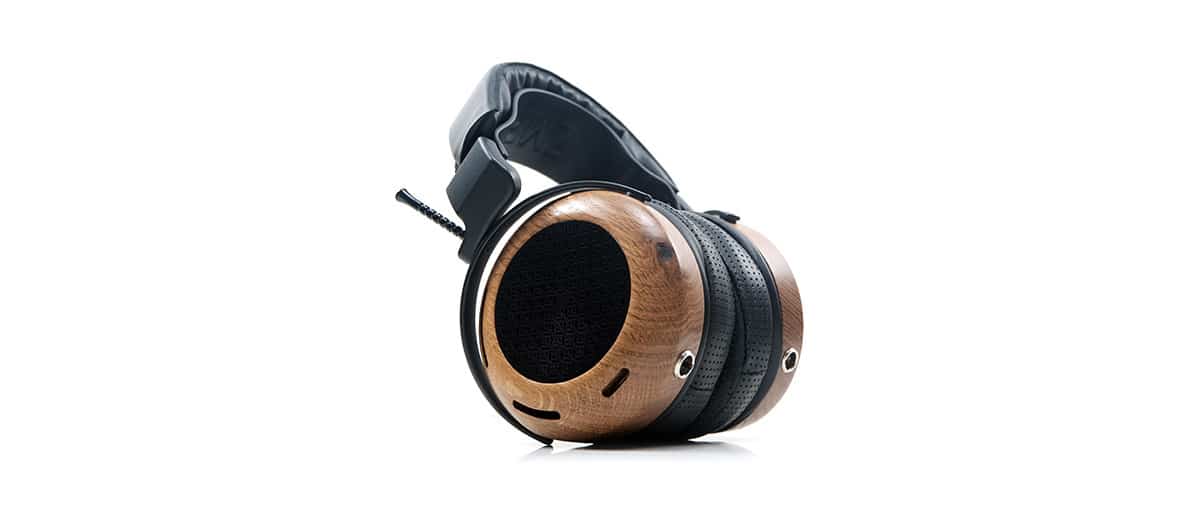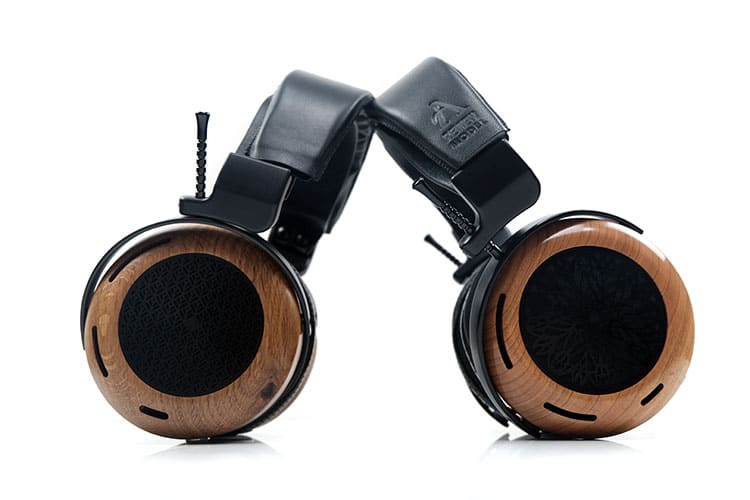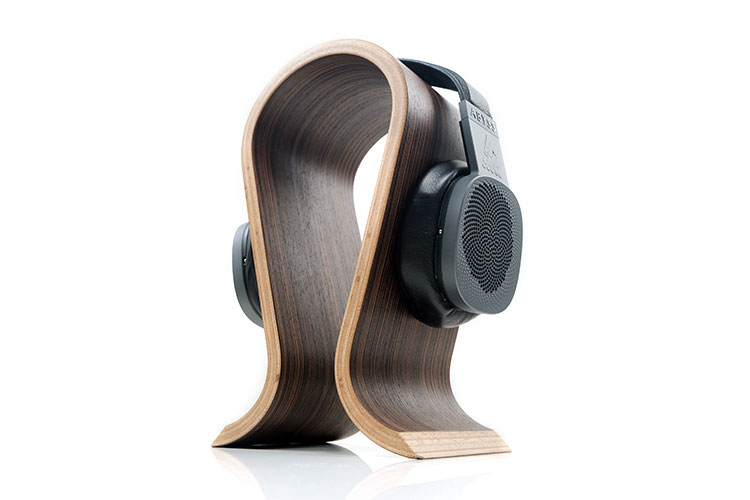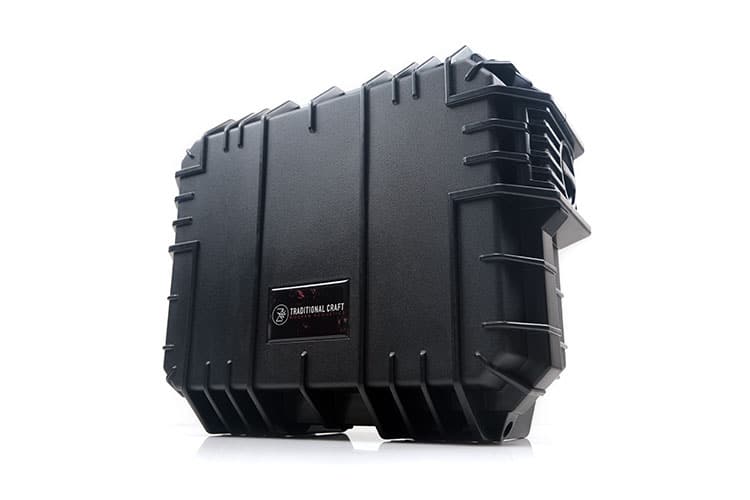Select Comparisons
All impressions were completed using the Caldera Stock pads combined with the Feliks Audio Envy and the HA-300MK2 amplifiers in balanced mode and the dCS Bartok as the supporting DAC.
ZMF Headphones Atrium
$2499.99
Just to note we used the perforated mesh version of the Atrium along with the stock pads for this comparison. I you want to read our complete review of the Atrium from earlier this year click here.
Technical
Despite similar external looks, the Atrium is very different internally. Inside, you have a single Biocellulose ‘N52 Atrium Tuned’ 50mm dynamic driver which is a stark contrast to the 80mm planar magnetic driver inside the Caldera.
Having said that there is some overlap in the surrounding acoustic technology with both using an ADS damping system first design for the Atrium. However, because the damping system is a customizable in-house tech, the final version for each headphone is a different design to accommodate their contrasting soundwave management.
One area that has not seen any development for the Caldera, (yet), is the Atrium’s various mesh systems that sit in front of the driver opening between the baffle and the inner pad opening. You get two options, a stock solid version that keeps the sound signature very smooth and a perforated version that adds a little more spice to the top end.
Neither of these headphones is super sensitive and both need power but in different ways. The Atrium is high in impedance at 300Ω and a reasonable 98dB SPL. It needs a good quality amplifier that can supply high levels of voltage such as the HA-300MK2 or the Feliks Audio Envy.
The Caldera is rated a little on the higher side for a modern planar at 60Ω and lower for SPL at 95dB. It will operate like most planars requiring decent voltage and current though not as demanding as some competing high-end alternatives such as the Susvara.
Design
The external design differences are mainly focused on the choice of wood for the cup, the new pad designs, and indirectly the slight adjustment in weight from the heavier planar magnet arrays.
The choice of wood we have here is stunning with Cherry for the Atrium and White Oak for the Caldera. The cherry is a lighter grain with more of a lacquered finish whereas the Caldera white oak is a darker grain, slightly rawer and more rustic in visuals. The venting slots on the cups are exactly the same.
The grills also differ and both have alternative choices though both here are black aluminum finishes. If pushed, I think the Atrium Rose Window gothic design is the more grandiose looking though the machining on the Caldera lattice pattern might be the more difficult, engineering-wise.
Pads are a big factor for these two headphones also. The Caldera pads are new flute-designed wedge shapes formed as part of the CAMS airflow management system and play a big role in the delivery of the soundwaves. All pad options are unique to this headphone only.
The Atrium isn’t so specific and can use pads from a wider range of previous ZMF headphones, such as the Auteur and the Verite. That being said, all pads for each headphone do affect the performance. There is also a suggestion from ZMF that they could release a perforated flute-shaped pad for the Atrium at a later date.
All else is quite matched on these two headphones including a choice of aluminum or magnesium for the frame, the crescent pressure strap system, and the mini-XLR cable connections. The only nuance beyond that is the weight, which I have the Caldera as a bit heavier subjectively despite it being closer on paper.
Performance
The key differences for me are in the bass and mids’ performance with some nuanced treble adjustments. On a technical level, it’s all about the acoustical arrangement and the staging quality.
It’s the more neutral-toned Caldera that digs the deepest and stretches the tallest with that powerful sub-bass planar presence that outmuscles the dynamic drive inside the Atrium. The warmer Atrium is punchy, with good extension but is comparatively attenuated below 50Hz.
You can hear the difference that makes, not just in notes that dip to that pitch but in instruments whose lower order requires a solid well-textured fundamental. The Caldera simply does it better giving you a denser textural quality at the very low end.
I prefer the Caldera paired with the Feliks Audio Envy because of the additional power it can deliver to that planar bass. However, even with both headphones on the same amp, the Caldera is a shade narrower on the macro level but cleaner and more resolving within. A stronger treble sheen with the stock pads gives micro-detail more presence.
On the flip side, the Atrium soundstage is more expansive and casts a wider macro presentation, really filling out acoustical space impressively. Paired with the HA-300MK2 it paints an arena-like quality to its presentation but the lusher slower tone masks some micro-detail that I can pick up a bit easier on the Caldera.
The Caldera is also a bit more forward in the mids around the 2-3k and closer to the Harman Target Response curve here with a gentle lift pushing some vocal pitches further forward.
The Atrium sounds comparatively relaxed through the mids though its slightly thicker timbral quality can mask similar vocal pitches so they do not sound lifeless or thinned out and lost in the mix.
Dan Clark Audio EXPANSE
$3999.99
The Expanse is DCA’s latest open-back flagship headphones reviewed by us just last month and scored very highly indeed. You can read our full review of the EXPANSE here.
Technical
Both these headphones are flagship planar magnetic open-back headphones and both come loaded with their respective company’s latest technology.
DCA and ZMF’s development have dovetailed each other quite beautifully starting out with T50p mods over a decade ago and here we are now with unique damping systems and their own in-house designed planar driver.
Ironically, you could argue the EXPANSE AMTS and the Caldera’s ADS have the same soundwave management objective and the same customizable ability though both approaches are quite different.
The drivers are not too far off in terms of size either at 80mm, (Caldera) versus 76mm, (EXPANSE). However, for DCA this is their 4th generation V-Planar as opposed to something entirely new for the Caldera.
The V-Planar inside the EXPANSE is single-sided with 11 magnets positioned on the outside of the driver in a single array as opposed to the double-sided CAMS system inside the Caldera. That will also be a factor in the additional weight of the Caldera.
The EXPANSE has a lower nominal load rating of 23Ω compared to the Caldera at 60Ω which has some gold plating on the trace levels that stiffens the resistance level. However, it’s the EXPANSE that is less sensitive at approximately 86 – 87 dB/mW compared to the 95dB of the Caldera.
The Caldera benefits from a good amplifier for sure, but the EXPANSE absolutely needs it to shine.
Design
A massively different approach to headphone design but both are very comfortable to wear, perhaps 2 of the most comfortable headphones I have tested this year. The weight difference isn’t huge at 415g compared to 490g, nevertheless, the EXPANSE does have an edge and you can feel that edge when wearing them.
The EXPANSE ovoid cup shape combined with the excellent pressure balance makes this a very steady headphone that easily clears your ears and provides super comfort in the process. If I have to make a call though it has more vertical pressure than lateral but not by a huge amount.
The Caldera has more of a lateral pressure bias in the clamping though the deep pads do a really nice job of mitigating any potential discomfort. It also feels like the crescent strap is doing a bit more work in pressure dispensation compared to the EXPANSE version which rarely breaks a sweat.
Aesthetics-wise, the EXPANSE does look more futuristic with some clever weight-saving craftmanship, and that fold-in-half articulation that makes it super compact for travel. The Caldera wood finish is beautiful but it is a traditional headphone design and comparatively a lot bigger.
Performance
There is an obvious and nuanced in terms of the difference between these two headphones. The obvious for me is the additional low-end power and larger hall-like staging quality of the Caldera versus the more controlled EXPANSE bass and intimate or narrower presentation.
The low-end and fundamental of the Caldera are much more impactful. Not that the EXPANSE lacks a sub-bass presence there is just more of it from the Caldera and sustained for a much longer to about 300Hz with only a minor drop up to 1k.
The EXPANSE has a solid punch but is comparatively neutral from 300Hz to 800Hz so instrumental presence in the lower mids is not quite as forceful or as dense sounding.
The nuance is the mids where the EXPANSE delicately positions things a bit more vocal-centric for me and with a very slightly more refined or accurate tonal quality. The Caldera is the warmer and denser tone of the two with the beefier instrumental and lusher vocal performance.
I suspect the EXPANSE follows the Harmon Target Response curve a bit more to the letter through the mids and indeed the Caldera has a narrower midrange bump from 2-3k whereas the EXPANSE is more gradual from 1k and peaks 2-4k.
Secondary to that, the Caldera pushes down a bit more from 4-6k and opts instead to give the performance a bit more upper treble 8k emphasis whereas the EXPANSE gently attenuates from 5k onwards and just slightly below the target curve.
It possibly explains a slight difference in the timbre with just a hint more treble overtone in the Caldera mids and vocals. The drop in the Caldera lower treble will also mask any harmonic dissonance in its percussion timbre from that peak so it still sounds quite smooth.
Abyss Headphones Diana TC
$4495
This is a 3rd generation Diana design and the latest in the Company’s new TC driver rollout. You can read our review of the excellent Diana TC from earlier in the year here.
Technical
Both of these headphones are open-back planar designs. The Diana TC tends to have a symbiotic relationship for driver technology with its bigger sibling, the AB-1266, whereas the Caldera stands out on its own with a unique new driver.
This is also a smaller driver at 63mm compared to the Caldera’s larger 80mm. However, only 61mm is active on the ZMF driver and Abyss has tried to maximize its version with an improved trace design and a larger active surface area on the diaphragm so it is possible the gap between them is not huge.
Less is known about the acoustical design of the Diana TC compared to the wealth of information from ZMF on the Caldera save for its single-sided magnet array.
What we do know is the adjustments made to the acoustical space with a focus on creating a more open environment through wider gaps, (21.57%), in the Fibonacci pattern on the cup plates compared to their older models. I suspect there is nothing like the Atrium Damping System inside the Diana TC.
One thing that Abyss has done consistently since the original Diana is a similar flute-styled pad system though I do have to say the original versions were not hugely comfortable. The newer versions are much better but lack any perforation so do not work in the same manner for airflow management as the Caldera pads.
Despite the smaller driver, the Diana TC is the more demanding of the two headphones. It has a higher 69Ω impedance rating compared to Caldera’s 60Ω and a lower sensitivity level of 90dB compared to 95dB SPL.
Design
Of course, everyone will have their preferences but I just adore the petite design of the Diana TC. To have such a high performance from such a compact design is truly marvelous.
It may not have the folding articulation of the EXPANSE but it is nevertheless very transportable, almost portable, and at 390g certainly a lot smaller and lighter than the Caldera. ZMF fans will stay true to their bias and I cannot fault the beautiful wood cup finish of the Caldera. This is all about old-school charm versus modern urban chic.
Here is the kicker though. Despite all that praise for the Diana TC aesthetics and smaller form factor, the Caldera is the more comfortable of the two headphones.
The super thin headband on the Diana TC is the culprit here creating a narrow pressure hotspot from a slight vertical pressure bias after prolonged use. It is comfier than the Diana Phi version and the new Diana TC pads are now what I would define as very comfortable but still a bit behind the Caldera.
The Caldera feels the bigger headphone on your head and you may notice the additional weight and stronger clamp. However, the pressure balance from the crescent strapline combined with thicker and softer fluted pads feel comfier the longer you wear them.
A small tip for Diana TC owners, get a Sennheiser HD209 replacement headband strap. It fits perfectly and adds additional softness to the headband. Once on, the gap in comfort levels is very small indeed.
Performance
Personally, I would have both of these in my collection as their performances and general tuning offer a very different emphasis. They complement each other more rather than compete and suit different styles of music. On that basis, I dare say they will attract different preferences or owners.
The Diana TC is fast, ultra-quick in its transients, articulate in the highs, and with a slightly drier brighter timbre to emphasize that perception of speed. It’s a maestro for micro-detail with superb imaging handling complexity with maximum ease.
The staging is relatively wide and tall with a forward vocal image but it lacks comparative depth with a bass amplitude that is quite neutral and tight.
That can rob it a little of the necessary gusto for rhythm-centric music. This is more of a high-fidelity offering, slightly more analytical but gels really well with high-resolution or multi-layered audio tracks where pinpoint positioning and world-class instrumental separation are required.
The Caldera is all about power and depth with a stronger sub-bass presence and richer thicker timbre throughout. It is not as micro-detail focused with a longer decay but casts a bigger macro staging quality that gives you a strong perception of space.
It is also an emotional tone, one that is heavy on enjoyable PRaT and smoother and more euphonic through the mids and highs, one that works wonderfully well for rock, R&B, and EDM.
Our Verdict
The ZMF Headphones Caldera is an incredible high-end debut planar headphone. I was simply not expecting this huge emotionally enjoyable sound complete with that trademark easy-to-listen-to tuning. It also looks the ‘biz’ with those White Oak wood cup designs.
It has bags of power, one of the deepest bass responses I have heard this year, and an excellent expansive soundstage to let it all run free without a hint of congestion. Importantly, it is technically very capable with improved speed and clarity over the early Atrium release.
I would say you could easily let the hours tick away listening to the Caldera so it is just as well ZMF stuck to their trademark form factor and headband system to allow you to do that.
There is plenty of new competition out there this year with some high-end headphones that may be faster, and others with a more advanced design or higher comfort levels. However, very few tick all the boxes at once quite like the Caldera.
ZMF Headphones Caldera Specifications
- Impedance: 60 Ohms
- Driver: 80mm with CAMS Patent Pending technology
- Weight: 490 – 550 (weight varies depending on Chassis)
- Sensitivity: ~95dB/mW





